A Systems Thinking Approach towards Single-Use Plastics Reduction in Food Delivery Business in Thailand
Abstract
:1. Introduction
2. Systems Thinking and System Dynamics: Theory and Approach
2.1. Systems Thinking Theory
2.2. System Dynamics and Leverage Points Identification
3. Single-Use Plastic Reduction Initiatives in the Food Sector
3.1. Market Governance Initiatives
3.2. Private-Led Initiatives
3.3. Target Initiatives
3.3.1. No Cutlery Defaults
3.3.2. Packaging Procurement
3.3.3. Labelling Program
3.3.4. Deposit Return Scheme (DRS)
4. Results
4.1. Thematic Analysis
4.2. Qualitative System Dynamics Model (QSDM)
4.2.1. Problem Identification
4.2.2. Actors and Their Role in the System
4.2.3. Behavior-Over-Time Analysis
4.2.4. Causal Loop Diagram
- Production Stage
- 2.
- Use Stage
- 3.
- Postconsumption Stage
4.2.5. QSDM Configuration
5. Discussion
5.1. The Leverage Points
5.1.1. Benefit Alignment
5.1.2. Cost and Profit
5.1.3. Postconsumption Waste Management System
5.1.4. Research and Development (R&D)
5.1.5. Laws, Regulations, and Standards
5.1.6. Partnerships and Cooperation
5.2. System Intervention Strategies
5.2.1. Mid-Term Strategies
- Behavioral Instruments: No cutlery default and Eco-labelling program
- 2.
- Market-based Instruments: Private procurement and subsidization
5.2.2. Long-Term Strategies
- Market-based Instruments: Price correction
- 2.
- Infrastructure and Systems Provision
6. Conclusions
Supplementary Materials
Author Contributions
Funding
Institutional Review Board Statement
Informed Consent Statement
Data Availability Statement
Conflicts of Interest
References
- The World Bank Group. Market Study for Thailand: Plastics Circularity Opportunities and Barriers; The World Bank Group: Washington, DC, USA, 2020. [Google Scholar]
- The Standard Wealth. Cloud Kitchen, the Revolution of the Restaurant Industry, Bet on Delivery Growth after COVID-19; The Standard Wealth: Rajasthan, India, 2021. [Google Scholar]
- Kasikorn Research Center. Food Delivery Business Is Becoming More Competitive after COVID-19; Kasikorn Research Center: Bangkok, Thailand, 2020. [Google Scholar]
- Tanakasempipat, P. Plastic Piles Up in Thailand as Pandemic Efforts Sideline Pollution Fight; Reuters: London, UK, 2020. [Google Scholar]
- Pollution Control Department. Thailand State of Pollution Report 2020; Pollution Control Department, Ministry of Natural Resources and Environment: Bangkok, Thailand, 2021.
- Jangprajak, W. Thailand’s Roadmap on Plastic Waste Management and Current Initiatives on Single-Use Plastic in Food Delivery and Takeaway; Pollution Control Department: Bangkok, Thailand, 2020. [Google Scholar]
- Jitpleecheep, P. Food Passion Tries to Cut Plastic Waste; Bangkok Post: Bangkok, Thailand, 2019. [Google Scholar]
- Kasikorn Research Center. Eco-Friendly Food and Beverage Packaging Market May Reach THB13-16 Billion in 2025 (Current Issue No.3137); Kasikorn Research Center: Bangkok, Thailand, 2020. [Google Scholar]
- Thailand Environment Institute. Plastic Waste Problems after the New Wave of COVID-19; Thailand Environment Institute: Bangkok, Thailand, 2021. [Google Scholar]
- Thampanishvong, K.; Wibulpolprasert, W.; Karnchanapimonkul, P. Plastic Waste from Food Delivery: Being Fulfilled without Creating Environmental Impact during COVID-19 Lockdown; Thailand Development Research Institute (TDRI): Bangkok, Thailand, 2020. [Google Scholar]
- Liu, C.; Bunditsakulchai, P.; Zhuo, Q. Impact of COVID-19 on Food and Plastic Waste Generated by Consumers in Bangkok. Sustainability 2021, 13, 8988. [Google Scholar] [CrossRef]
- Peszko, G. Plastics: The Coronavirus Could Reset the Clock; World Bank Blogs: Washington, DC, USA, 2020. [Google Scholar]
- Van Dam, Y.K. Sustainable Consumption and Marketing; Wageningen University: Wageningen, The Netherlands, 2016. [Google Scholar]
- Jackson, T. Motivating Sustainable Consumption; Sustainable Development Research Network: Surrey, UK, 2005. [Google Scholar]
- van Dam, Y.K.; van Trijp, H. Interventions to encourage sustainable consumption. APSTRACT: Appl. Stud. Agribus. Commer. 2016, 10, 51–58. [Google Scholar] [CrossRef] [PubMed]
- Welch, D.; Warde, A. Theories of practice and sustainable consumption. In Handbook of Research on Sustainable Consumption; Edward Elgar Publishing: Cheltenham, UK, 2015; pp. 84–100. [Google Scholar] [CrossRef] [Green Version]
- Berkhout, F. Negotiating Environmental Change: New Perspectives from Social Science; Edward Elgar Publishing: Cheltenham, UK, 2003. [Google Scholar]
- Meadows, D.; Wright, D. Thinking in Systems: A Primer; Chelsea Green Publishing: White River Junction, FL, USA, 2008. [Google Scholar]
- Caulfield, C.W.; Maj, S.P. A case for systems thinking and system dynamics. In Proceedings of the 2001 IEEE International Conference on Systems, Man and Cybernetics, e-Systems and e-Man for Cybernetics in Cyberspace (Cat. No. 01CH37236), Tucson, AZ, USA, 7–10 October 2001; pp. 2793–2798. [Google Scholar]
- Forrester, J.W. System dynamics—The next fifty years. Syst. Dyn. Rev. J. Syst. Dyn. Soc. 2007, 23, 359–370. [Google Scholar] [CrossRef]
- Hjorth, P.; Bagheri, A. Navigating towards sustainable development: A system dynamics approach. Futures 2006, 38, 74–92. [Google Scholar] [CrossRef]
- Nguyen, N.C.; Bosch, O.J. A systems thinking approach to identify leverage points for sustainability: A case study in the Cat Ba Biosphere Reserve, Vietnam. Syst. Res. Behav. Sci. 2013, 30, 104–115. [Google Scholar] [CrossRef] [Green Version]
- Myrtveit, M. The World Model Controversy; The University of Bergen: Bergen, Norway, 2007. [Google Scholar]
- Bayer, S. Business Dynamics: Systems Thinking and Modeling for a Complex World; JSTOR: New York, NY, USA, 2004. [Google Scholar]
- Abdelkafi, N.; Täuscher, K. Business Models for Sustainability from a System Dynamics Perspective. Organ. Environ. 2015, 29, 74–96. [Google Scholar] [CrossRef]
- Egerer, S.; Cotera, R.V.; Celliers, L.; Costa, M.M. A leverage points analysis of a qualitative system dynamics model for climate change adaptation in agriculture. Agric. Syst. 2021, 189, 103052. [Google Scholar] [CrossRef]
- Hsieh, Y.H.; Yuan, S.T. Modeling service experience design processes with customer expectation management: A system dynamics perspective. Kybernetes 2010, 39, 1128–1144. [Google Scholar] [CrossRef] [Green Version]
- Lee, C.; Ng, K.; Kwong, C.; Tay, S. A system dynamics model for evaluating food waste management in Hong Kong, China. J. Mater. Cycles Waste Manag. 2019, 21, 433–456. [Google Scholar] [CrossRef]
- Zhang, C.; Qin, C. Exploration of the Growing Trend of Electric Vehicles in Beijing with System Dynamics method and Vensim model. In Proceedings of the 32nd International Conference of the System Dynamics Society, Delft, The Netherlands, 20–24 July 2014. [Google Scholar]
- Braun, V.; Clarke, V. Using thematic analysis in psychology. Qual. Res. Psychol. 2006, 3, 77–101. [Google Scholar] [CrossRef] [Green Version]
- Corbin, J.; Strauss, A. Basics of Qualitative Research: Techniques and Procedures for Developing Grounded Theory; Sage Publications: Thousand Oaks, CA, USA, 2014. [Google Scholar]
- Boyatzis, R.E. Transforming Qualitative Information: Thematic Analysis and Code Development; Sage: Thousand Oaks, CA, USA, 1998. [Google Scholar]
- Wolstenholme, E.F. A methodology for qualitative system dynamics. In Proceedings of the 1985 System Dynamics Conference, Keystone, CO, USA, 2–5 July 1985; pp. 1049–1058. [Google Scholar]
- Fortmann-Roe, S.; Bellinger, G. Beyond Connecting the Dots: Modeling for Meaningful Results; RealKM: Berlin, Germany, 2013. [Google Scholar]
- Coyle, G.; Exelby, D. The validation of commercial system dynamics models. Syst. Dyn. Rev. J. Syst. Dyn. Soc. 2000, 16, 27–41. [Google Scholar] [CrossRef] [Green Version]
- Meadows, D.H. Leverage Points: Places to Intervene in a System; Whole Earth: Menlo Park, CA, USA, 1999. [Google Scholar]
- Abson, D.J.; Fischer, J.; Leventon, J.; Newig, J.; Schomerus, T.; Vilsmaier, U.; Von Wehrden, H.; Abernethy, P.; Ives, C.D.; Jager, N.W. Leverage points for sustainability transformation. Ambio 2017, 46, 30–39. [Google Scholar] [CrossRef] [PubMed] [Green Version]
- Marshall, R.S.; Brown, D. The strategy of sustainability: A systems perspective on environmental initiatives. Calif. Manag. Rev. 2003, 46, 101–126. [Google Scholar] [CrossRef] [Green Version]
- Randers, J. From limits to growth to sustainable development or SD (sustainable development) in a SD (system dynamics) perspective. Syst. Dyn. Rev. J. Syst. Dyn. Soc. 2000, 16, 213–224. [Google Scholar] [CrossRef]
- Dhanshyam, M.; Srivastava, S.K. Effective policy mix for plastic waste mitigation in India using System Dynamics. Resour. Conserv. Recycl. 2021, 168, 105455. [Google Scholar] [CrossRef]
- Destyanto, A.R.; Kirana, P.S.; Ardi, R. Model conceptualization of system dynamics for evaluating extended producer responsibility strategy in plastic waste management policy in Indonesia. In Proceedings of the 2019 5th International Conference on Industrial and Business Engineering, Kowloon City, Hongkong, 27–29 September 2019; pp. 106–109. [Google Scholar]
- Jati, R.K.; Ardi, R. Conceptualization of Systems Dynamics Analysis on Informal Plastic Waste Management Systems in Indonesia. In Proceedings of the 3rd Asia Pacific Conference on Research in Industrial and Systems Engineering 2020, Depok, Indonesia, 16–17 June 2022; pp. 203–207. [Google Scholar]
- Ren, G.; Zhao, C. Research on the Pollution of Express Plastic Packaging Based on System Dynamics. In Proceedings of the E3S Web of Conferences, Yogyakarta, Indonesia, 20–21 July 2022; p. 02011. [Google Scholar]
- Cordier, M.; Uehara, T. How much innovation is needed to protect the ocean from plastic contamination? Sci. Total Environ. 2019, 670, 789–799. [Google Scholar] [CrossRef] [PubMed]
- Deutsche Gesellschaft für Internationale Zusammenarbeit (GIZ). Reducing Single-Use Plastics in Food Delivery and Takeaway; Deutsche Gesellschaft für Internationale Zusammenarbeit: Bonn, Germany, 2020. [Google Scholar]
- Ellen MacArthur Foundation. Reuse—Rethinking Packaging; Ellen MacArthur Foundation: Cowes, UK, 2019. [Google Scholar]
- Jun-tae, K. South Korean Govt, Industry Target 20% Cut in Plastic Use; The Nation Thailand: Bangkok, Thailand, 2020. [Google Scholar]
- Boston Consulting Group. The Consumer Sentiment Series; Boston Consulting Group: Boston, MA, USA, 2021. [Google Scholar]
- Chulalongkorn University Transportation Institute. Survey Result of Food Ordering and Consumption during the Lockdown; Chulalongkorn University Transportation Institute: Bangkok, Thailand, 2020. [Google Scholar]
- Thai Health Promotion Foundation. Thai Health Watch 2021; Thai Health Promotion Foundation: Bangkok, Thailand, 2020. [Google Scholar]
- FirstCraft. Thailand’s Food Delivery Growth after COVID-19: The Key Insights from SOCIAL Listening Tools; FirstCraft: Budapest, Hungary, 2021. [Google Scholar]
- Seyfang, G. The new economics of sustainable consumption. In Minería Transnacional, Narrativas del Desarrollo y Resistencias Sociales. Buenos Aires: Biblos; Springer: Berlin/Heidelberg, Germany, 2009. [Google Scholar]

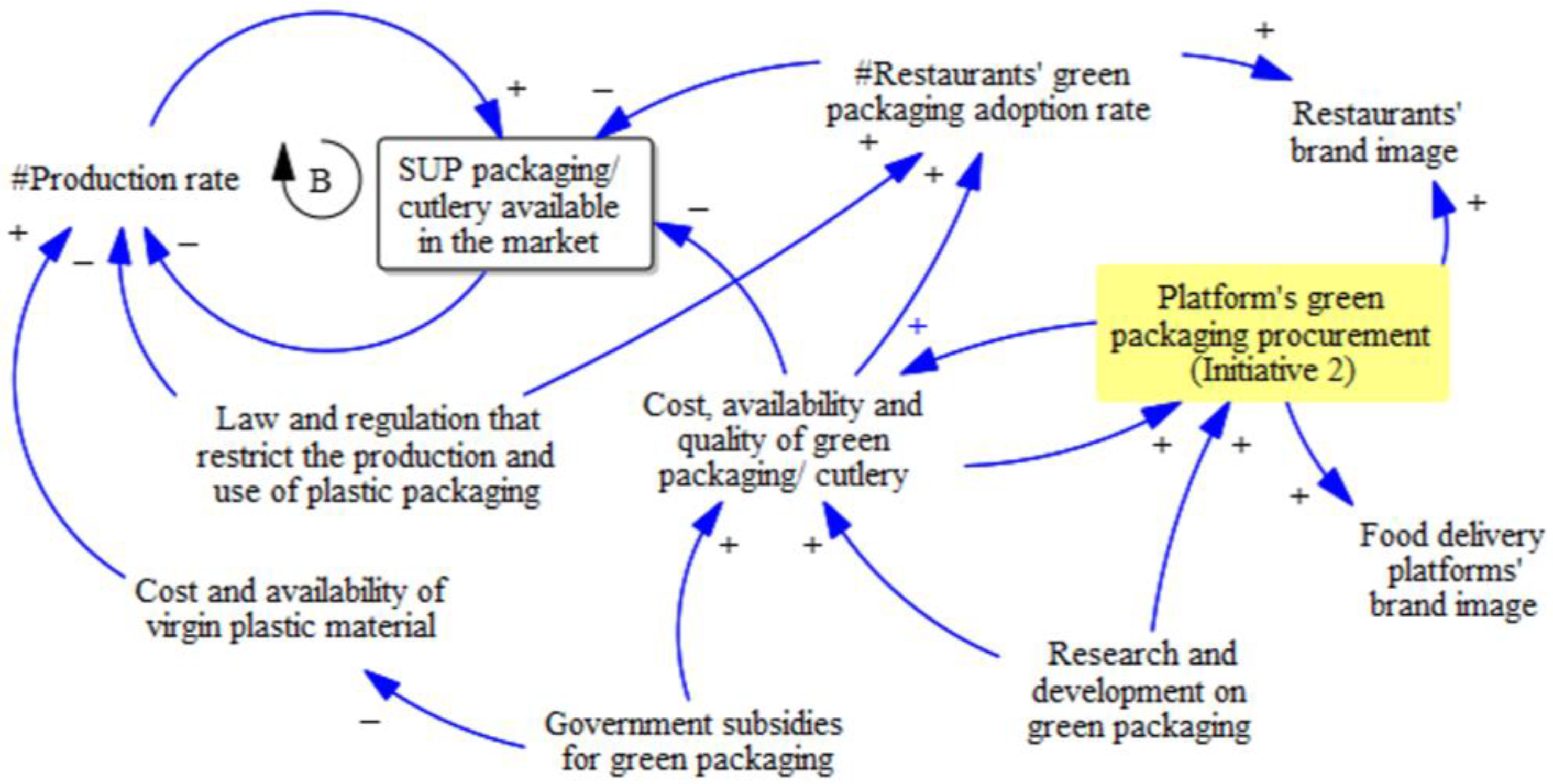
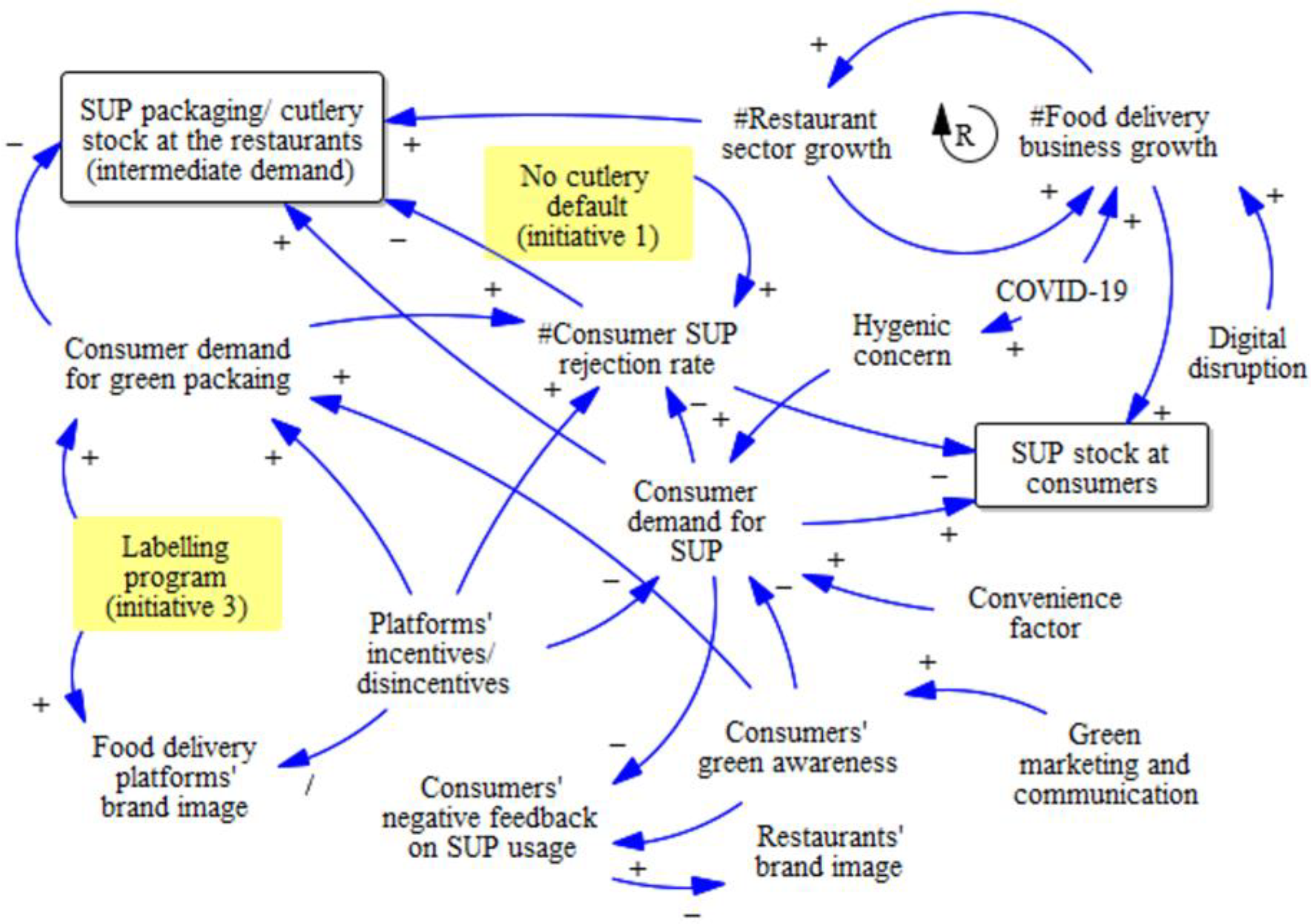
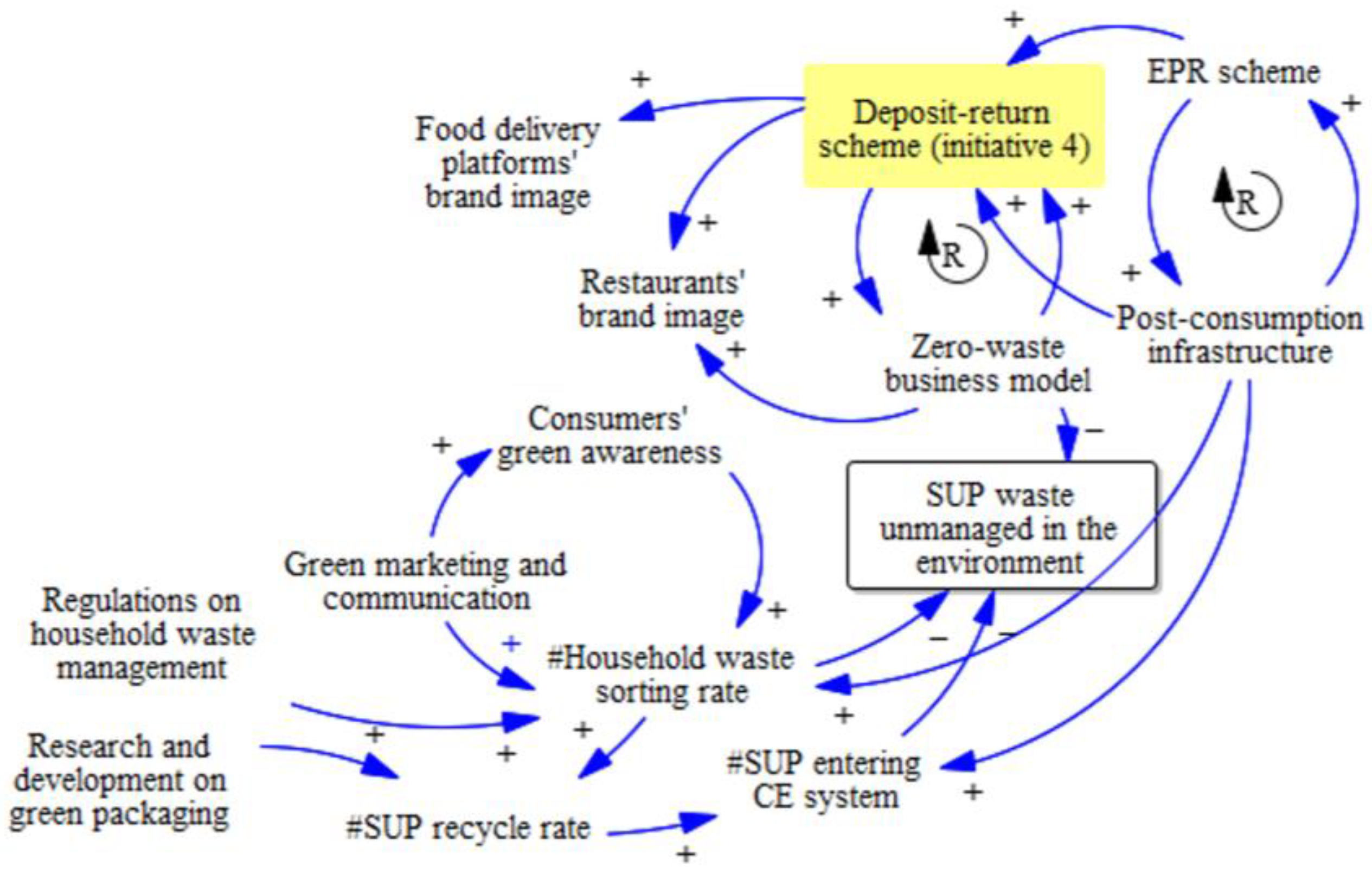
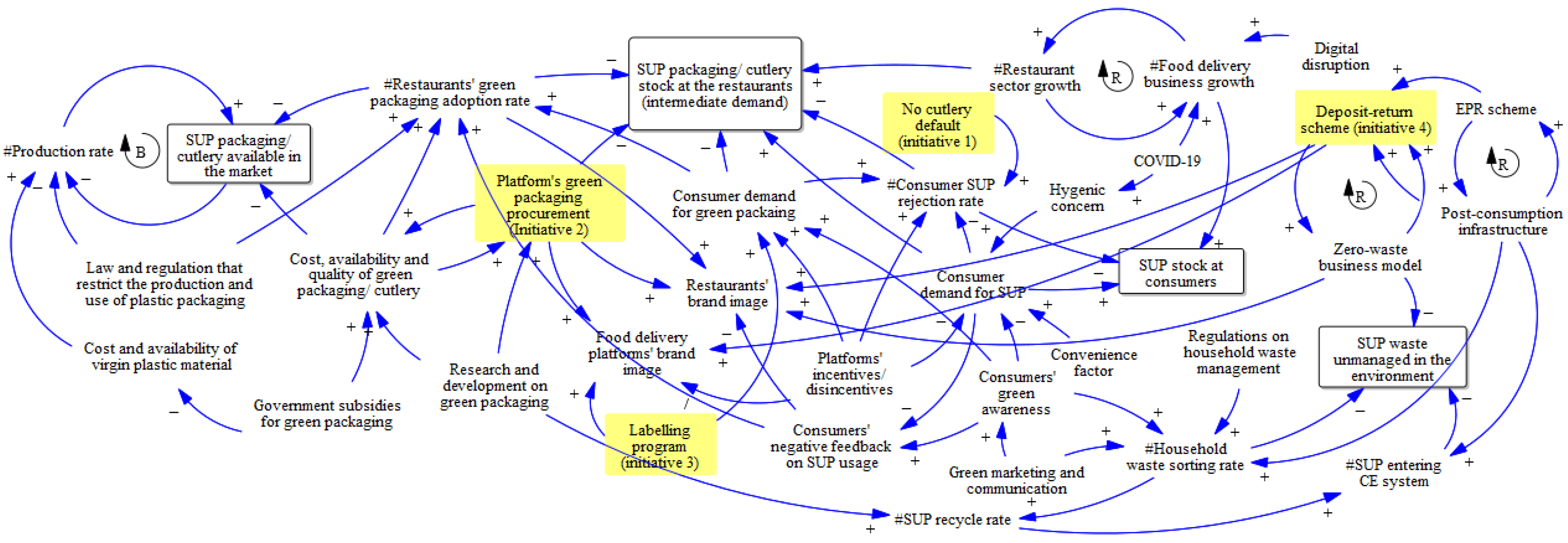
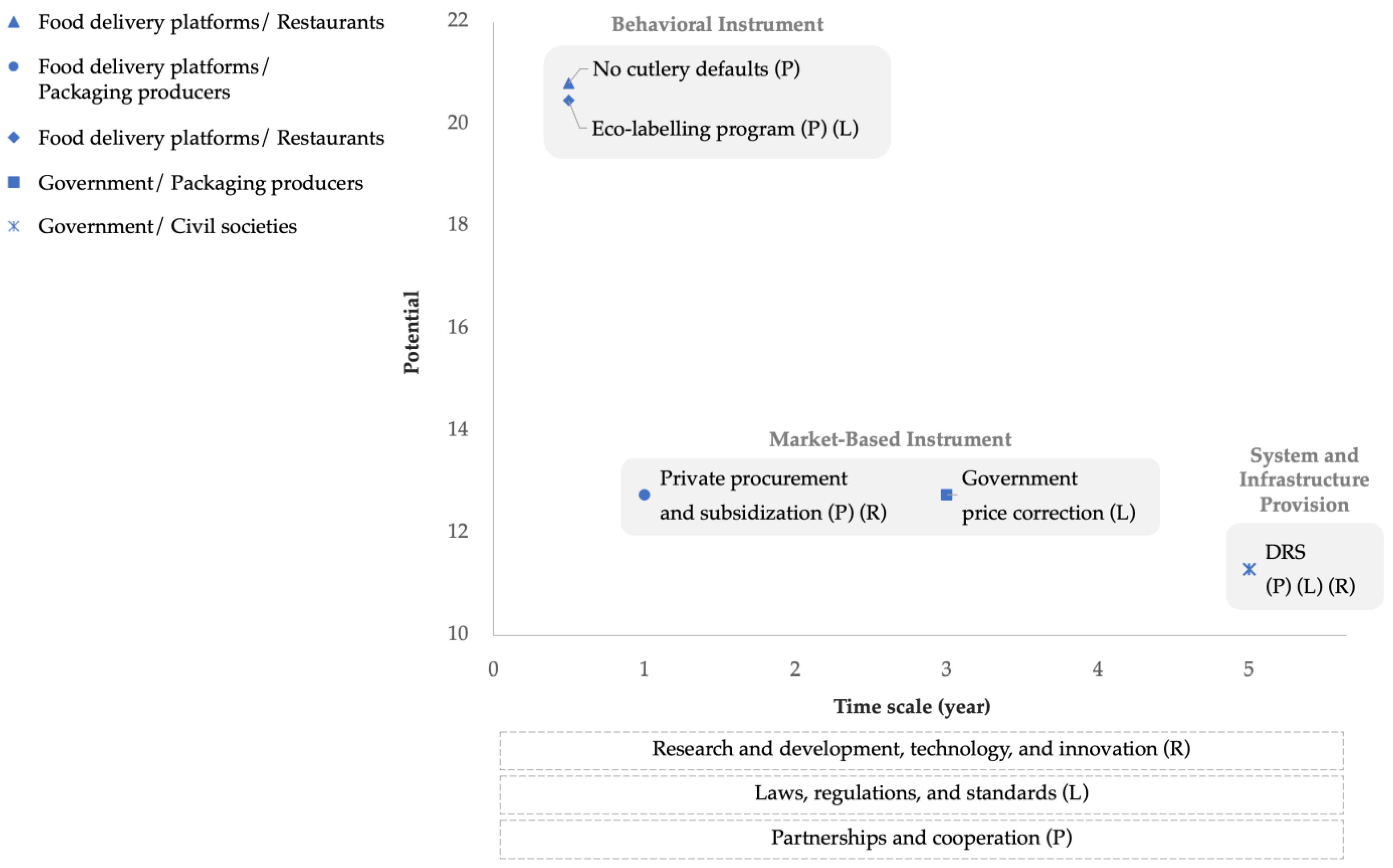
| System Theme | Explanation | Score | |
|---|---|---|---|
| Section 1: Mental Models | |||
| Theme 1 | Demand-driven, bottom-up approach towards sustainability | Promote awareness and behavioral change. Demand should be created before supply | 9 |
| Theme 2 | Incentives and cost-minimization principle | Incentives should be provided. Every stakeholder works on the cost-minimization principle | 14 |
| Theme 3 | WTP, awareness, and value gap | WTP, awareness, and value gaps are presented at every level, from suppliers to consumers | 11 |
| Theme 4 | Voluntary schemes do not work | Voluntary schemes have no significant result. Business fears losing its competitiveness. Mandatory waste management responsibilities should be applied at every level. | 6 |
| Section 2: Systemic Structures | |||
| Theme 5 | Incentive alignment | Any sustainable initiative will be successful if every party is satisfied with the benefits received | 12 |
| Theme 6 | Internalization through incentives and disincentives | Internalization concepts should be considered through the provision of incentives and disincentives (tax and non-tax) | 9 |
| Theme 7 | Incentives for for-profit actors | Being profit-led, incentives are needed. Business cannot go on with projects that are not profitable | 10 |
| Theme 8 | Expectation on business responsibility | The business sector is expected to have a certain level of responsibility. However, under multi-stakeholder conditions, business alone cannot deliver significant change | 7 |
| Theme 9 | Standards, frameworks, regulations | The system needs standards, frameworks, and regulations for every stakeholder to ensure mutual direction | 11 |
| Theme 10 | Government subsidies | The government should provide subsidies as a pricing mechanism to push down the price and lift the demand for green packaging | 11 |
| Section 3: Patterns | |||
| Theme 11 | Platforms and restaurants’ role and relationships | Platforms and restaurants’ roles, relationships, and the scopes of responsibility need to be clearly addressed | 7 |
| Theme 12 | Research and development (R&D) | R&D at the production stage should be promoted (e.g., mono-material packaging and alternative packaging) | 9 |
| Theme 13 | The current system is linear, not circular | The system is linear, not circular. The existing waste management system is not supportive of a circular economy | 7 |
| Section 4: Events | |||
| Theme 14 | Customer-centric | Businesses need to focus on communication/consumer experience, impression, and satisfaction | 9 |
| Theme 15 | Lack of efficient postconsumption waste management system | Need an efficient postconsumption waste management system | 13 |
| Theme 16 | Niches as system disruptors | Sustainable niches such as startups and civil society organizations can disrupt the system with technologies and organization flexibility | 5 |
| Theme 17 | Have willingness but not equal capacity | The business sector has the willingness to act responsibly, but they (especially the restaurants) do not have equal capacity | 12 |
| Theme 18 | Lack of alternatives | Lack of alternatives (not practical, no economies of scale) | 12 |
| Initiative Theme | Explanation | Score | |
|---|---|---|---|
| Initiative 1: No Cutlery Defaults | |||
| Theme 1 | Clear communication to consumers | To avoid the risk of complaints, opt-in and opt-out should be clearly communicated | 9 |
| Theme 2 | Practical limitation | Restaurants usually give out plastic cutlery regardless of consumers’ requests | 12 |
| Theme 3 | Easy and cost-saving | Easy to do. Restaurants can save costs | 10 |
| Initiative 2: Packaging Procurement | |||
| Theme 1 | Consumer’s packaging choice should not be restricted | Choices of packaging should be available, especially when consumer charges are involved | 8 |
| Theme 2 | Low availability of alternatives | Lack of greener alternatives for most types of meals | 11 |
| Theme 3 | Needs government subsidies | Small retailers cannot bear green packaging costs. Food delivery platforms cannot provide long-term subsidies | 10 |
| Initiative 3: Labelling Program | |||
| Theme 1 | Easy to do but require green demand and supply | Without adjusting demand and supply, labelling may not lead to long-term changes | 9 |
| Theme 2 | Incentives to both restaurants and consumers | Incentives can draw restaurants and consumers to participate in the program | 12 |
| Initiative 4: Deposit Return Scheme (DRS) | |||
| Theme 1 | High cost, not economically viable | This scheme requires high investment, expected economic return is low | 14 |
| Theme 2 | An inconvenient scheme in convenience-based business | While food delivery service offers convenience and speed, this scheme is inconvenient for every party | 13 |
| Theme 3 | Consumers’ hygienic concerns | In the event of a pandemic, the reuse model may prove difficult | 9 |
| Evaluation Criteria | |||
|---|---|---|---|
| Expected Outcome | Resources Required * | Chance of Success | |
| Target initiative | |||
| 1. No cutlery default | 6.91 | 3.37 | 7.21 |
| 2. Packaging procurement | 5.49 | 8.08 | 5.34 |
| 3. Labelling program | 7.16 | 3.85 | 7.20 |
| 4. Deposit return scheme | 6.14 | 8.87 | 4.03 |
Publisher’s Note: MDPI stays neutral with regard to jurisdictional claims in published maps and institutional affiliations. |
© 2022 by the authors. Licensee MDPI, Basel, Switzerland. This article is an open access article distributed under the terms and conditions of the Creative Commons Attribution (CC BY) license (https://creativecommons.org/licenses/by/4.0/).
Share and Cite
Wongprapinkul, B.; Vassanadumrongdee, S. A Systems Thinking Approach towards Single-Use Plastics Reduction in Food Delivery Business in Thailand. Sustainability 2022, 14, 9173. https://doi.org/10.3390/su14159173
Wongprapinkul B, Vassanadumrongdee S. A Systems Thinking Approach towards Single-Use Plastics Reduction in Food Delivery Business in Thailand. Sustainability. 2022; 14(15):9173. https://doi.org/10.3390/su14159173
Chicago/Turabian StyleWongprapinkul, Boonchanit, and Sujitra Vassanadumrongdee. 2022. "A Systems Thinking Approach towards Single-Use Plastics Reduction in Food Delivery Business in Thailand" Sustainability 14, no. 15: 9173. https://doi.org/10.3390/su14159173
APA StyleWongprapinkul, B., & Vassanadumrongdee, S. (2022). A Systems Thinking Approach towards Single-Use Plastics Reduction in Food Delivery Business in Thailand. Sustainability, 14(15), 9173. https://doi.org/10.3390/su14159173






